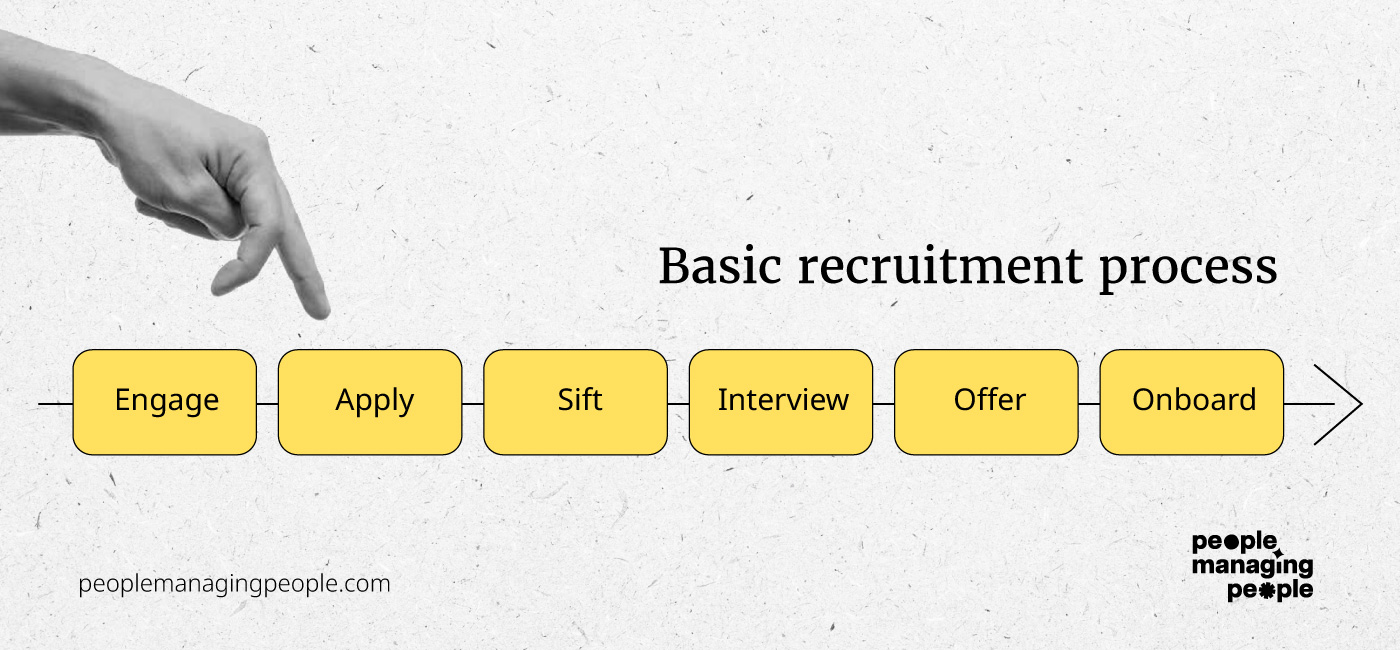Recruitment is a critical business function and notoriously tricky to get right. Use this guide to help you understand what it is and how to approach it so you can hire the talent you need.
What Is Recruitment?
Recruitment, or recruiting, is the process of an organization finding new talent to help meet its strategic goals. This can include employer branding, marketing, sourcing, screening, interviewing, making a job offer, and onboarding.
As anyone who’s ever had a hand in recruitment will tell you, it can be in equal measure a rewarding and frustrating process, but one that is vital to the success of an organization.
What Does Recruitment Involve?
Like most successful processes, recruitment starts with careful planning to get a clear understanding of the talent needs of the organization.
Your approach to recruitment can take a variety of looks, whether it's full cycle recruiting or something more collaborative across business functions.
- Workforce planning: The process of analyzing skills gaps vs business goals and identifying current and future hiring needs.
- Creating job descriptions: Creating a document that outlines the job requirements, skills, qualifications, activities, responsibilities, and duties of a specific role within a company. It may also include details like the salary range.
- Job posting and advertising: Posting job descriptions and ads in the relevant places.
- Sourcing Candidates: Searching for candidates in internal candidate databases, leveraging LinkedIn and other professional networks, attending job fairs and recruitment events, and encouraging referrals.
- Marketing: In truth, all marketing efforts can contribute to recruitment, but there are recruitment-specific marketing activities such as crafting an attractive careers page.
- Candidate screening: Reviewing information about the candidate that is available to you (candidate’s resume, cover letter, LinkedIn profile etc.) and deciding whether they could be a good fit for the role.
- Interviewing: Scheduling interviews with shortlisted candidates and conducting various types of interviews (e.g., phone, video, in-person, panel).
- Assessments and testing: Administering and reviewing technical, psychometric, and aptitude tests.
- Making a job offer: Offering the chosen candidate the role and negotiating salary, benefits, etc.
Tip: Leveraging anything from free recruiting software to enterprise recruiting software can make your recruitment process much more efficient.
What Are The Different Types Of Recruitment?
When it comes to recruitment, you have options:
- Internal recruitment: Filling a job vacancy with a candidate from within the organization. This can include promotions, transfers, or short-term assignments.
- External recruitment: Going into the market and finding candidates from outside the organization.
- Retained recruiting: Also known as retained search, is a specialized recruitment service where an organization hires an external recruitment firm on a retainer to fill a high-level or specialized position.
- Contingency recruitment: Contingency recruiting is the same as retained recruitment except the recruitment firms are paid only if they successfully place a candidate in the position.
- Staffing: Hiring employees to fill temporary, contract, or permanent positions within an organization.
- Outplacement recruiting: A service provided by organizations to support employees who are transitioning out of the company, typically due to layoffs, restructuring, or downsizing. The goal of outplacement services is to help these employees find new employment opportunities and transition smoothly to their next career phase.
The Recruitment Process
In his excellent article on the recruitment process, Liam Reese breaks down the recruitment process into these stages:

- Engage: All activities that make candidates aware of your job opportunities e.g. posting job descriptions and other recruitment marketing activities.
- Apply: The point between a candidate deciding to apply and formally submitting an application. The application might not be direct from the applicant e.g. via an agency, directly sourced, or referral.
- Sift: The work that happens before a formal interview where we whittle down the handful of applicants we want to interview.
- Interview: Assessing a candidate’s skills and choosing the best candidate for the position based on the factors most important to you.
- Offer: The point between you deciding on your candidate and them accepting or declining the offer.
- Onboard: Perhaps more accurately referred to as preboarding, this is the process between somebody accepting the offer and their start date.
It's worth noting that if you don't have your process mapped out in a recruiting process flowchart like the one above, it's probably time to change that.
7 Tips For Effective Recruiting
We’ve spoken to a lot of hiring experts over the years and here are their top tips for an effective recruitment function.
1. Build a strong employer value proposition and brand
Organizations that consistently hire talent that’s the right fit for them are ones that obsess over their employer brand.
The employer brand is how an organization is perceived as an employer by the wider world. Do they treat people fairly and help them grow and develop, are they working on interesting projects, do they champion a wider cause beyond making profits for shareholders?
So much goes into developing and maintaining a brand, but it will act as an anchor for all your recruitment-related efforts, including how you market yourself to potential candidates.
As Eric Harris, Founder of employer branding agency Mindhandle, points out “A strong employer brand is a magnet for values-aligned talent because it doesn’t beg the candidate “Do you want a job?” Instead, it asks, “Are you like us?” That’s what we want: candidates who have self-identified as people who will succeed in the organization. Everything else is academic.”
The basis of your employer brand is your employer value proposition (EVP) i.e. what an employer promises to deliver to its employees in exchange for their skills, expertise, and commitment.
2. Utilize existing employees
If you get your EVP and employer brand right, then your employees should be your biggest champions. This is especially true when it comes to small business recruiting.
They can help out by directly referring potential candidates, sharing open roles in their networks, and participating in recruitment marketing activities like “a day in the life” videos.
Further, as Scott Millar, Senior Vice President, Human Resources, Canon Solutions America, Inc puts it, “Current Canon employees know our company, culture, and the qualities that make people successful here, so this is a great way to start identifying talent for key positions.”
Tip: Use employee referral software to automate the referral process and make it easier for workers to refer qualified candidates for open positions within the company.
3. Frequent communication and collaboration between recruiters and hiring managers
Hire is a collaborative process and many experts we talk to stress the need for frequent communication between HR/recruitment teams and hiring managers.
“People and culture professionals must make it a priority to collaborate with managers and teams to understand their current and future staffing needs, as well as the skills and expertise required to meet those needs.” - Weronika Niemcyzk, Chief People & Culture Officer, Cyncly
4. Make use of modern tools
We’ve come a long way since the first staffing software solutions came onto the market in the form of the applicant tracking system (ATS).
A modern hiring tech stack can help you measure recruiting KPIs, make everyone’s jobs easier and create a better experience for the candidate too.
“To make sure we’re finding and engaging with the right talent, we additionally take a high touch, high-tech approach to hiring and attracting talent. That initiative has been highly successful for us and involves the right tools and resources to deliver a positive candidate experience, including our BCGYou app for candidates looking to get more information on the firm, connect with current BCGers, apply for roles, prepare for cases, and find details on the interview process.” - Amber Grewal, Boston Consulting Group
To see what’s possible, check out our shortlists of the best recruiting software and best applicant tracking systems.
Other useful tools include talent acquisition software and candidate sourcing tools.
If you're hiring frequently for remote roles, it's a good idea to invest in some robust video interview software to help you connect with candidates easily too.
5. Develop key recruiting metrics
Recruitment metrics and analytics is vital to help you measure and improve your recruitment function and hire the talent you need.
You can read more in our article on recruiting metrics, but here’s an overview of some basic and more advanced metrics for you to track:
- Time to Fill and Time to Hire: Time to Fill measures the duration from when a position is posted until a candidate is hired, while Time to Hire measures the time from when a candidate applies to when they are hired.
- Number of hires vs. open positions: This metric tracks the number of hires made in relation to the number of open positions, indicating the effectiveness of the recruitment function.
- Source of hire: Identifies the origin of candidates (e.g., job boards, social media, referral programs), helping allocate recruitment resources efficiently.
- Number of applicants: Tracks the volume of applicants for a position, providing insight into job posting effectiveness and candidate interest.
- Conversion ratio: Measures the percentage of candidates moving from one stage of the hiring process to the next, helping identify bottlenecks.
- Hiring funnel speed: Tracks the time candidates spend in each stage of the hiring process, ensuring the process is efficient and timely.
- Offer acceptance rate: The ratio of job offers accepted to those made, reflecting the attractiveness of job offers and the company's competitiveness.
- Candidate net promoter score (CNPS): A score based on candidate feedback on their recruitment experience, used to improve the hiring process.
- Diversity of pipeline: Measures the diversity of candidates in the hiring pipeline, helping to promote inclusive hiring practices.
- Employee referrals: Tracks the number and quality of employee-referred candidates, indicating employee engagement and network strength.
Some of the key benefits of an ATS are affording you the ability to easily collect and analyze key recruiting metrics, track the efficacy of your hiring efforts, and refine your recruitment budget.
6. Carefully structured interviews
As interviewing is such a crucial element of the recruitment process, it’s no surprise that they’re something our experts are hyper-vigilant about, favoring a collaborative, structured approach that effectively assesses skills and competencies.
“Conducting in-depth interviews with candidates can help to identify their strengths, skills, and experiences and determine if they are a good fit for the role. For example, at ABBYY our hiring process has changed so that more people are involved in the hiring process. The hiring managers no longer make the decision. Instead, we have created a hiring ‘group’.” - Weronika Niemcyzk
More on this in Mariya Hristova’s excellent article on how to interview someone.
7. Build a diverse talent pool
Diversity is healthy in business as it is in nature. Many experts we spoke to highlighted the advantages of drawing from a diverse candidate pool and ensuring the process is as inclusive as possible.
“It’s critical to understand the current make-up of the team that the prospective candidates would be joining and seek to understand where we can continue to welcome new voices to the table. The recruiters share a toolkit with leaders that covers everything from how to identify new areas to source talent from, the importance of having a diverse interview team, and then process steps we can take to mitigate bias in everything from our job postings to the interview process.” - Randy Tosch, VP Talent, Grainger.
A great way to source diverse candidates is to hire international employees.
8. Outsource
Recruitment can be challenging, particularly when hiring your first employees.
This is why recruitment process outsourcing (RPO) is so popular to help relieve the burden on internal teams. They can help with:
- Candidate sourcing
- Interviewing techniques and training
- Hiring process optimization
- Onboarding.
For more, check out our pick of the best RPO services.
Remember, Recruitment Is About People
This has been a relatively brief run-through of recruitment and what it entails. There's a lot of thought that goes into a full recruitment strategy, from developing recruiting email templates to altering your candidate sourcing strategy and investing in social media recruiting.
Covering everything in granular detail is beyond the scope of this article, but I'll end with one last nugget of wisdom from hiring expert, Mariya Hristova.
“Recruiting is first and foremost a people profession, so the focus should be on the people!”
If you're looking to keep learning more about all things recruiting, it's worth taking a look at our list of the best recruiting newsletters to subscribe to.
Join The People Managing People Community
For further guidance on recruitment and all things talent management, join our supportive community of HR and business leaders sharing knowledge and best practices to help you grow in your career and make greater impact in your organization.




